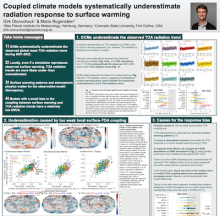Coupled climate models systematically underestimate radiation response to surface warming
Dirk
Olonscheck
Max Planck Institute for Meteorology
Poster
A realistic representation of the top-of-the-atmosphere (TOA) radiation response to surface warming is key for trusting climate model projections. We show that coupled models with freely evolving ocean-atmosphere interactions systematically underestimate the observed global TOA radiation trend during 2001-2022 in 432 simulations of eight single-model initial-condition large ensembles. While the CERES observed 22-year trend is 1.02Wm-2, the maximum simulated 2001-2022 trend of each large ensemble ranges from 0.39 to 0.98Wm-2. This shows that the model-observation discrepancy cannot be explained by internal variability. In contrast, the observed surface warming over the last two decades is well within the simulated range of internal variability. We reject possible reasons for the underestimated TOA radiation trends such as biases in the magnitude of simulated internal variability, local mean-state climatological biases and an observed extreme trend. Instead, from locally regressing surface temperature and TOA radiation trends, we find that the model-observation discrepancy is primarily caused by a too weak local surface-TOA coupling. We show the too weak local surface-TOA coupling to stem from both the models' inability to reproduce the observed surface warming pattern and from errors in the atmospheric physics affecting short- and longwave radiation. We further find that models with a better representation of this TOA radiation response to local surface warming have a relatively low equilibrium climate sensitivity. Our novel process-based metric to quantify the model-observation discrepancy thus links a model's current response to climate change to its behavior in the future.

Poster file
olonscheck-dirk-confronting-poster.pdf
(2.66 MB)
